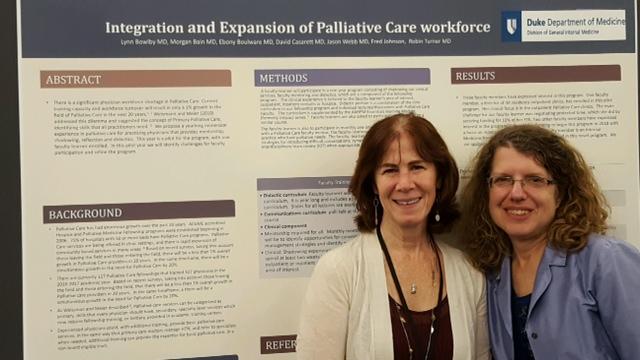
Drs. Lynn Bowlby (of Duke GIM) and Robin Turner (of Duke Palliative Care) presented a research poster at the Palliative and Supportive Care and Oncology Symposium, which took place October 27-28 in San Diego, California. Learn more about their research project below:
Title:
Integration and Expansion of Palliative Care Workforce
Authors:
Lynn Bowlby, MD, Robin Turner, MD, David Casarett, MD, Fred Johnson, Ebony Boulware, MD, Jason Webb, MD, Morgan Bain, MD
Background:
The specialty of Hospice and Palliative Medicine has grown out of the need for care of patients who are living longer with cancer and other serious illness and struggle with symptoms, decisions and care. Cancer patients and others often do not have access to Palliative Care (PC) services due to availability or accessibility of PC services. Since 2012, fellowship training is required for board eligibility but available programs do not meet the workforce need. As described by Weissman and Meier, viewing Palliative Care services in the context of a primary, secondary or tertiary focus, allows for the expansion of these services outside of the traditional fellowship training. With additional intensive training, it is possible that experienced physicians can fill workforce gaps by providing primary palliative care in the providers practice area such as a clinic.
Methods:
The faculty member who will participate in a yearlong training program based in the Palliative Care Clinic is the Director of the Outpatient Clinic. This clinic is the center of the Duke resident ambulatory experience for the duration of their training. The complexity of these patients is high and often the DOC is the only place that these patients receive care. The Palliative Care training program will provide the faculty member the opportunity to see patients in the cancer center with board certified palliative care physicians. There will be 3 areas of focus for the trainee: clinical experience, didactic information and mentorship from a board certified palliative care provider around faculty identified cases from her own practice.
Results:
We have developed a yearlong intensive training program for experienced faculty to gain skills in Palliative Care.
Conclusions:
- It is hoped that this will allow for integration of primary palliative care into patient care areas where there is no formal palliative care program.
- Integration of Palliative Care principles in the clinic to address symptoms of chronic severe illness as well as difficult conversations with more confidence and skill.
- Earlier palliative care management–develop a systematic approach to assessing needs in high risk populations ie. Hospital Discharge reviews, now commonly done at the clinic.